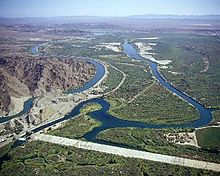| Laguna Diversion Dam | |
|---|---|
 Overhead of dam facing north Overhead of dam facing north | |
 | |
| Location | Imperial County, California / Yuma County, Arizona, US |
| Coordinates | 32°49′22″N 114°29′39″W / 32.82278°N 114.49417°W / 32.82278; -114.49417 |
| Construction began | 1903; 122 years ago (1903) |
| Opening date | 1905; 120 years ago (1905) |
| Owner(s) | U.S. Bureau of Reclamation |
| Operator(s) | Imperial Irrigation District |
| Dam and spillways | |
| Type of dam | Rock-fill weir, concrete surface |
| Impounds | Colorado River |
| Height | 43 feet (13 m) |
| Length | 4,780 feet (1,460 m) |
| Spillway type | Controlled service |
The Laguna Diversion Dam is a rock-filled diversion dam on the Colorado River. It is located 13 miles (21 km) northeast of Winterhaven, CA–Yuma, AZ on Imperial County route S24. Constructed between 1903 and 1905, the dam was the first dam built on the Colorado River and subsequently ended boat travel to the north.
History
After the passage of the Reclamation Act by the US Congress in 1902, the U.S. Bureau of Reclamation began constructing the dam under the Yuma Project in 1903. This project was the first development of the U.S. Reclamation Service along the Lower Colorado River and featured the Laguna Diversion Dam, a pumping station and a series of canals. On July 6, 1905 the contract to build the dam was awarded to J. G. White and Company who started construction less than two weeks later. Deliveries of cement were a problem as they had to be delivered to Yuma by rail and to the construction site by wagons or steamboat. Poor rock quality at local quarries also posed a problem that consistently delayed construction, 50% of the weak rock was unusable. Even after their contract was supplemented to encompass the rock quality delays, J. G. White and Company still did not meet their deadline and the Bureau of Reclamation took over construction in early 1907.
To solve the cement delivery problems, the Bureau of Reclamation had built a levee on the California side on the dam that was topped by a rail-line by March 1908. Beforehand, they had also gained the cooperation of the Southern Pacific Railroad who agreed to deliver cement directly at the dam site. The rock problem was solved when the Bureau raised the upstream and downstream cofferdams with rock waste and topped them with rail lines that could deliver rock-fill much faster. By December 1908, the water bypass around the dam was complete and workers began to pour the rock-fill. Three large concrete walls supported by 6-inch sheet-wood pilings were built across the river for the dam's foundation. Rock-fill was placed in between and on the outsides of these walls for support. The California sluiceway consisted of three iron gates while the Arizona had one. Mexican-Americans mostly worked on the dam while a few Native American Indians did as well. Skilled white-labor worked in the cooler months.
The Laguna Dam's design and size made it a peculiar structure for the time. The dam, a weir, was merely 43 ft. tall, almost two-thirds of which were built below the riverbed. Subsequently, the dam only raised the river ten feet. Modifications to the dam's downstream talus were done between 1923–1924. After the creation of the Imperial Dam 5-miles upstream, the Laguna Diversion Dam was no longer needed and its California diversion outlets were closed on June 23, 1948. Since then, the dam serves to regulate the outflows of the Imperial Dam and often does not impound a large reservoir.
Swastika design
The Laguna Dam was decorated with numerous swastikas, thus developing the eventual nickname "Swastika Dam." The swastikas present on this structure were not put there for any sort of National Socialist ("Nazi"), or otherwise racist or socio-political reasons. They were placed there prior to Adolf Hitler's effectively having altered the popular meaning of the swastika within Western societies.
Fish species
- Largemouth Bass
- Striped Bass
- Crappie
- Bullhead catfish
- Catfish (Channel)
- Catfish (Flathead)
- Tilapia
- Redear Sunfish
- Green Sunfish

Front of dam - Bluegill Sunfish
- Mullet
- Carp
- Bullfrogs
See also
- Mittry Lake – Created by the dam.
- County Route S24
References
- "Yuma Project". U.S. Bureau of Reclamation. Retrieved 13 July 2010.
- ^ A. Stene, Eric. "Yuma Project and Yuma Auxiliary Project" (PDF). History of Reclamation Projects. U.S. Bureau of Reclamation. Retrieved 14 July 2010.
- "Laguna Diversion Dam". U.S. Bureau of Reclamation. Retrieved 13 July 2010.
- Information and Education Division (2007). "Arizona Fishin' Holes" (Document). Phoenix, AZ: Arizona Game and Fish Department.
- Map of Laguna Diversion Dam
External links
- USBR Laguna Diversion Dam Website
- Historic American Engineering Record (HAER) No. AZ-87, "Laguna Diversion Dam, Laguna Dam Road, Yuma, Yuma County, AZ", 4 data pages
- Swastika Dam article by Walter Smoter Frank
- USBR History of Laguna Dam
- Arizona Lake Levels Archived 2010-07-16 at the Wayback Machine
| Colorado River system | |||||||||
|---|---|---|---|---|---|---|---|---|---|
| Jurisdictions |
|     | |||||||
| Canyons |
| ||||||||
| Natural features |
| ||||||||
| Tributaries | |||||||||
| Engineering |
| ||||||||
| Designated areas | |||||||||
| Related topics | |||||||||
| Crossings of the Colorado River | ||||
|---|---|---|---|---|
| ||||
- Dams in California
- Dams in Arizona
- Dams of the Lower Colorado River Valley
- Dams on the Colorado River
- Buildings and structures in Imperial County, California
- Winterhaven, California
- Buildings and structures in Yuma County, Arizona
- United States Bureau of Reclamation dams
- Dams completed in 1905
- Historic American Engineering Record in Arizona
- 1905 establishments in Arizona Territory
- 1905 establishments in California